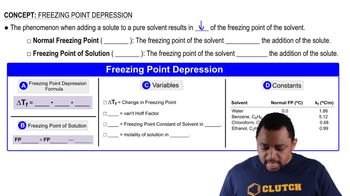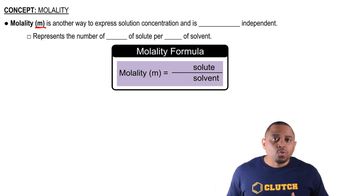Here are the essential concepts you must grasp in order to answer the question correctly.
Freezing Point Depression
Freezing point depression is a colligative property that describes how the freezing point of a solvent decreases when a solute is added. The extent of this depression is directly proportional to the molality of the solute and is quantified by the equation ΔTf = Kf * m, where ΔTf is the change in freezing point, Kf is the freezing point depression constant, and m is the molality of the solution.
Recommended video:
Freezing Point Depression
Molality
Molality (m) is a measure of the concentration of a solute in a solution, defined as the number of moles of solute per kilogram of solvent. It is crucial for calculating colligative properties like freezing point depression, as it provides a direct relationship between the amount of solute and the effect on the solvent's properties.
Recommended video:
Molar Mass of Ethylene Glycol
The molar mass of ethylene glycol (C2H6O2) is essential for converting between grams and moles when performing calculations related to freezing point depression. Ethylene glycol has a molar mass of approximately 62.07 g/mol, which allows for the determination of how many moles are present in a given mass, facilitating the calculation of molality in the context of the problem.
Recommended video:




